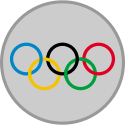Taekwondo na Letnich Igrzyskach Olimpijskich 2000
| |||
 Hala State Sports Centre - miejsce zawodów w taekwondo podczas Letnich Igrzysk Olimpijskich 2000. | |||
| Data | 27 – 30 września | ||
|---|---|---|---|
| Miejscowość | |||
| Organizator | |||
| Liczba konkurencji | 8 | ||
| Liczba zawodników | 102 (48 kobiet i 54 mężczyzn) | ||
| Liczba reprezentacji | 50 | ||
Taekwondo na Letnich Igrzyskach Olimpijskich 2000 w Sydney zostało rozegrane po raz pierwszy jako oficjalna olimpijska dyscyplina sportowa - wcześniej dwukrotnie (1988, 1992) rozegrano ją jako dyscyplinę demonstracyjną. Zawody odbyły się w dniach 27 – 30 września w hali State Sports Centre. Zawodnicy rywalizowali w ośmiu kategoriach wagowych (po cztery dla mężczyzn i kobiet).
Medaliści
Mężczyźni
| Waga | |||
| 58 kg | |||
| 68 kg | |||
| 80 kg | |||
| +80 kg |
Kobiety
| Waga | |||
| 49 kg | |||
| 57 kg | |||
| 67 kg | |||
| +67 kg |
Tabela medalowa zawodów
| Poz. | Państwo | Łącznie | |||
|---|---|---|---|---|---|
| 1 | 3 | 1 | 0 | 4 | |
| 2 | 1 | 1 | 0 | 2 | |
| 1 | 1 | 0 | 2 | ||
| 4 | 1 | 0 | 0 | 1 | |
| 1 | 0 | 0 | 1 | ||
| 1 | 0 | 0 | 1 | ||
| 7 | 0 | 1 | 0 | 1 | |
| 0 | 1 | 0 | 1 | ||
| 0 | 1 | 0 | 1 | ||
| 0 | 1 | 0 | 1 | ||
| 0 | 1 | 0 | 1 | ||
| 12 | 0 | 0 | 2 | 2 | |
| 13 | 0 | 0 | 1 | 1 | |
| 0 | 0 | 1 | 1 | ||
| 0 | 0 | 1 | 1 | ||
| 0 | 0 | 1 | 1 | ||
| 0 | 0 | 1 | 1 | ||
| 0 | 0 | 1 | 1 |
Linki zewnętrzne
- Oficjalny raport z Letnich Igrzysk Olimpijskich 2000 w Sydney – Taekwondo, digital.la84.org, [dostęp 2022-05-18].
- Taekwondo at the 2000 Summer Olympics, olympedia.org, [dostęp 2022-05-18].
Media użyte na tej stronie
Pictograms of Olympic sports - Taekwondo. This is unofficial sample picture. Images of official Olympic pictograms for 1948 Summer Olympics and all Summer Olympics since 1964 can be found in corresponding Official Reports.
Autor: https://phabricator.wikimedia.org/diffusion/GOJU/browse/master/AUTHORS.txt, Licencja: MIT
An icon from the OOjs UI MediaWiki lib.
Autor: https://phabricator.wikimedia.org/diffusion/GOJU/browse/master/AUTHORS.txt, Licencja: MIT
An icon from the OOjs UI MediaWiki lib.
Autor: B1mbo, Licencja: CC BY-SA 2.5
Drawing of a gold medal, based on Olympic rings.svg.
Autor: B1mbo, Licencja: CC BY-SA 2.5
Draw of a silver medal, based in Olympic rings.svg.
- The joining of the rings is not correct drawn.
Autor: B1mbo, Licencja: CC BY-SA 2.5
Drawing of a bronze medal, based on Olympic rings.svg.
Autor: Pedro A. Gracia Fajardo, escudo de Manual de Imagen Institucional de la Administración General del Estado, Licencja: CC0
Flaga Hiszpanii
Official flag used by the Fédération Internationale de Football Association (FIFA) to represent Chinese Taipei in association football matches. Also used at the Olympics from 1986 to 2010.
The flag of Navassa Island is simply the United States flag. It does not have a "local" flag or "unofficial" flag; it is an uninhabited island. The version with a profile view was based on Flags of the World and as a fictional design has no status warranting a place on any Wiki. It was made up by a random person with no connection to the island, it has never flown on the island, and it has never received any sort of recognition or validation by any authority. The person quoted on that page has no authority to bestow a flag, "unofficial" or otherwise, on the island.
Autor: maix¿?, Licencja: CC BY-SA 2.5
A gold medal with the olympic rings inside
Autor: maix¿?, Licencja: CC BY-SA 2.5
A silver medal with the olympic rings inside
Autor: maix¿?, Licencja: CC BY-SA 2.5
A bronze medal with the olympic rings inside
Chinese Taipei Olympic Flag. According to the official website of Chinese Taipei Olympic Committee, Blue Sky(circle) & White Sun(triangles) above the Olympic rings is neither the National Emblem of the Republic of China, nor the Party Emblem of Kuomintang (KMT), but a design in between, where the triangles do not extend to the edge of the blue circle, as registered at International Olympic Committee in 1981 and digitally rendered in 2013. Besides, the blue outline of the five-petaled plum blossom is broader than the red one. Moreover, the CMYK code of the blue one and the Blue Sky & White Sun is "C100-M100-Y0-K0", and different from the Olympic rings (C100-M25-Y0-K0). Note that it's the only version recognized by IOC.
Olympic Rings without "rims" (gaps between the rings), As used, eg. in the logos of the 2008 and 2016 Olympics. The colour scheme applied here pertains to the 2016 Olympics in Rio de Janeiro.
Olympic Rings without "rims" (gaps between the rings), As used, eg. in the logos of the 2008 and 2016 Olympics. The colour scheme applied here pertains to the 2016 Olympics in Rio de Janeiro.
Autor: J Bar, Licencja: CC BY 3.0
Sydney Olympic Park Sports Centre




























